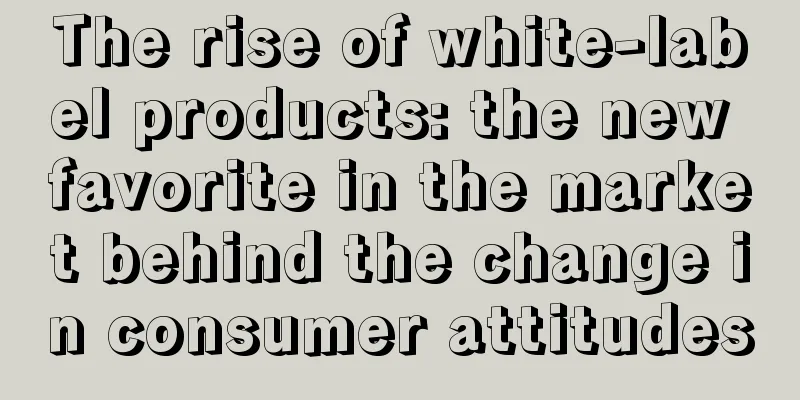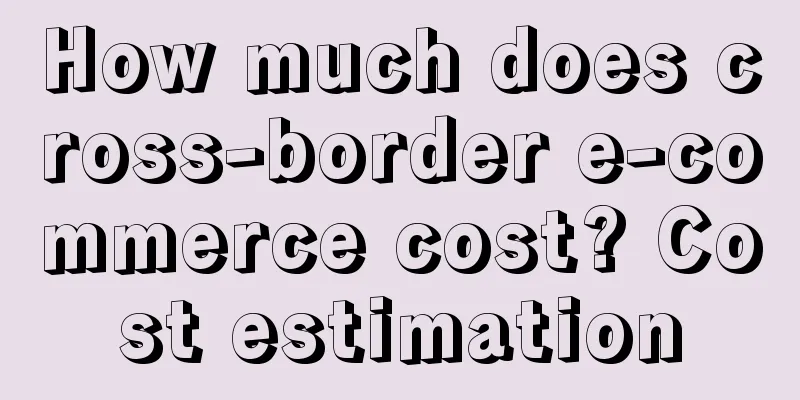The rise of white-label products: the new favorite in the market behind the change in consumer attitudes

"This canvas bag is nice, very cute and has enough capacity!" "This beef tendon is good. I bought it last time. It's fragrant and spicy, and very chewy." On Saturday afternoon, Weiwei muttered to herself as she started another half-day tour of the department store at MINISO. "I still like to visit this kind of collection store very much. It feels like visiting a small market. The variety is very rich, and the frequency of new products is also very high. It is similar to fast-moving clothing stores such as UR and ZARA. I come here from time to time to see what new products are available. Although I have never heard of many of the "white-label" names, they are all pretty and fun. And the most important point is that they are cheap! This kind of collection store is similar to Japan's 100-yen store. It feels like visiting an offline 1688 store. You can buy a lot of things with only one or two hundred yuan each time, which can really increase your sense of satisfaction." "White label" or "factory brand" refers to products with low brand recognition produced by small manufacturers. From the earliest white label servers to later white label laptops, now furniture, food, daily necessities, beauty, almost all consumer fields have corresponding white label products. It can be said that white-label products are everywhere in life, whether in mom-and-pop stores on the streets or in brand-collection stores in large shopping malls. Although these products do not have a widespread brand effect, their prices are much lower than those of big brands, and they adopt a high cost-effective pricing strategy. If you think about it this way, the category of white-label products is like a natural 1688. And its popularity also proves the consumption concept of modern young people - online shopping can be 1688, and physical stores can be white-label. 1. Say goodbye to brand premiumThe concept of "white label" was born in contrast to "brand". In the past few decades, domestic consumers have been obsessed with branded goods. Since the reform and opening up in the 1990s and China's accession to the WTO in 2000, foreign brands have flooded into the Chinese market. Consumers generally believe that "you get what you pay for" and "big brand products are good", and are unwilling to spend money on unknown brands. Having brand value means having a higher premium, so it is natural for big brands to sell at a higher price. During the period of rapid social and economic development, people's material lives are improving, their income levels are rising, the concept of "being better to yourself" is strengthened, big brands have no trouble selling, and the more expensive the brand, the more people buy it. The gears of fate began to turn in reverse around the COVID-19 pandemic in 2020. "Minimalist life is also good" and "staying at home may be okay"... people's consumption concepts have undergone a qualitative change. The trend of not wanting to pay a premium for brands has become increasingly prevalent, and from mid-range consumer goods to luxury goods, everyone has felt the bleakness of the economic winter to varying degrees. Brands have become less valuable, and young people have begun to take the lead in rectifying the market. Weiwei, who loves to shop at department stores, is one of the representatives. Compared to the crazy pursuit of famous brands in the early years, Weiwei's consumption concept has become much more Buddhist now. "Maybe it's because I'm getting older. Now I feel that brands are not that important. When I first used unbranded products, I had a little psychological barrier. After using them once or twice, I found that 'Huh? It's actually quite useful', and my acceptance was greatly improved. In fact, this is a psychological process. After breaking through, you will find that many things in life don't need to be bought with so much money just for the sake of face." A weak brand does not mean weak quality, and it cannot be directly equated with Low. Ma Zheng, chief analyst of the food and beverage industry at Cinda Securities, believes that it is relatively easy to raise prices for products consumed by the general public in the past period of time because the market has experienced a process from insufficient supply to oversupply in the process of users pursuing branding. Now that they are returning to quality and demanding cheapness, the quality red line and brand premium price will fall in these categories. When the wave of consumerism turned to extreme cost-effectiveness, the spring of white-label merchants quietly arrived. 2. The platform’s soul-searching decisionIt is true that e-commerce platforms have made white-label products successful, but in essence, e-commerce platforms and white-label products complement each other. In the era when Jack Ma was not yet "Papa Ma", Tmall had not yet been "born", and well-known brands simply looked down on doing business on Taobao. Jack Ma really needed a group of unknown brands to come to Taobao to compete. You know, it was free for merchants to open a store on Taobao at that time. Thanks to the large quantities of "Yiwu Small Commodity City-style" white-label goods, Taobao was able to create a world of low-priced goods and quickly occupy the minds of consumers with the "surrounding the city from the countryside" approach. “When Taobao was first established, the things on it were really cheap.” This may be a memory that will be permanently sealed in the hearts of old Taobao fans. The advent of the e-commerce era has provided unlimited space for white-label products. New brands and white-label manufacturers are often limited by insufficient start-up capital and manpower, and are unable to open up the market through conventional advertising, channels, etc. However, on e-commerce platforms, whether you are well-known or unknown, you can use the power of the platform to radiate to the whole country and acquire consumers, and the cost and speed of acquiring customers can be greatly reduced. As we all know, the golden decade of e-commerce has quietly passed, and now it is also a red ocean. So, at present, do e-commerce platforms still welcome white-label products? There is a disagreement among the bigwigs. For pure platform companies like Taobao, Pinduoduo, and 1688, brands do not make much difference to them . As long as they are willing to pay, they can find a spot on the platform to sell their products. However, as Taobao became bigger and stronger, its vision gradually became higher, and its preference for white-label products plummeted. Currently, the stores on the Taobao platform are mainly brand B stores and C stores. B stands for business, and most B stores are brand merchants, and C stands for individual (Customer). With the launch of the Taobao Special Platform, a natural barrier seems to have been erected between brand stores and white-label stores. Fortunately, platforms such as Pinduoduo and 1688 are more willing to use white-label products to promote their own cost-effectiveness, and small and medium-sized businesses have also taken the opportunity to find a new safe haven. During the three years of the epidemic, consumers have made a qualitative leap in their acceptance of white-label products with the rise of Kuaituantuan and community group buying. It's not that Tmall can't afford it, but 1688 is more cost-effective. Young people have gained low-cost happiness in the process of looking for substitutes. On the other hand, Video Account firmly stands on the side of the brand. According to a recent report by Ebrun, after Video Account raised the certification requirements for brand merchants from "sales and reviews on three external sites, Tmall, JD.com or Douyin, greater than 10" to "greater than 20" in September last year, Video Account updated the certification rules for brand merchants in early February this year, no longer requiring qualification certificates from external sites such as Taobao, JD.com, Pinduoduo and Douyin, but turning to the reference to the brand power classification admission standards officially formulated by Tencent, including brand listing, WeChat index, public account fans and other evaluation dimensions. Several practitioners said that the threshold for certifying Video Account brand merchants has been raised this time, and some categories are even higher than those of the above platforms. The difference in identity determines that video accounts are more willing to do brand business. First, compared to e-commerce platforms, video accounts are still in their early stages of selling goods. Big brands’ quality control, logistics, customer service, after-sales and other services are relatively mature, which to some extent reduces the management pressure of video accounts. Secondly, the market does not need a second Taobao or a second Pinduoduo. In a speech last year, Ma Huateng said: "We cannot follow others and do the same thing, but we must combine our own characteristics and make short videos for acquaintances to socialize." Judging from the current competitive landscape of various platforms, both white-label and branded products can have their own choices and develop simultaneously on multiple platforms, and consumers can also get what they need in the new retail era of a hundred schools of thought. 3. Different paths will eventually lead to the same destination?In recent years, the benefits of white-label products have been fully reflected in various fields, among which food is the most representative. Taking the snack market as an example, statistics released by the industry media "China Candy" show that branded products account for 20% to 25% of store sales revenue, with a gross profit of ≤10%; white-label products account for 60% to 65% of store sales revenue, with a gross profit of ≥30%; white-label products account for about 20% of store sales revenue, with a gross profit of ≥30%. It can be said that white-label snacks support most of the snack market. In the view of Chinese food industry analyst Zhu Danpeng, there are clear reasons why domestic white-label food products can flourish. "For Chinese food brands or products, the chain from production to consumer is very long. There is about 60% profit in the middle, so how to eliminate the middleman, how to optimize the supply chain, and how to optimize the channel level has become an important direction for many mass-market snack discount stores." A brand is always white-label when it is born, but no one wants to be white-label forever. White-label merchants who rely solely on low prices to conquer the public domain are unable to gain consumer stickiness and often only do one-time deals; whereas brand merchants win consumer loyalty by long-term cultivation of the private domain and usually have a higher repurchase rate. How can you quickly become famous without being well-known? The practice of selling snacks in bulk provides a good reference route. First of all, the snack industry is a market with many subdivisions and categories. There are countless suppliers, but most of them are white-label merchants. At the same time, even the leading snack brands generally have a low market share. According to the report of Whale Consultants' e-commerce big data, the market shares of Three Squirrels, Be & Cheery and Liangpin Shop are all around 5%, and the combined market share of the top 10 brands in terms of snack sales is only around 22%. This means that new brands still have plenty of opportunities to compete with leading companies. Secondly, the mass-market snack shop is not only a platform, but also serves as the first screen. Although all of them are white-label, the quality of white-label is also uneven. Mass-market snacks need to filter out unreliable merchants and place low-priced and high-quality items in stores even though they have not yet established a brand. Although consumers do not know these white-labels, they know snacks like Busy Snacks and Zhao Yiming Snacks. It can be said that the platform needs to bear a certain endorsement responsibility for the products it selects. Such an approach can, firstly, lay the foundation for the store's future repeat customers; secondly, it is a win-win situation, allowing white-label products to reach consumers more conveniently and adding strength to the rise of white-label products; thirdly, unqualified products can be eliminated in a relatively fair manner at the white-label stage. In the 2023 Tmall Double 11 pre-sale event, the little-known "Bibi Zan" rushed into the top three of the food store popularity list. Among the 15 categories of snacks Youming, the number of white-label products accounted for as high as 77%, and the sales volume contribution also reached 73%. But white-label products can still rest on their laurels. As Ma Zheng, chief analyst of the food and beverage industry at Cinda Securities, said, the white-label bonus has given many small and medium-sized entrepreneurs more opportunities to showcase their brands, but it does not mean that they do not need to build their brands - a brand needs to stand out from the massive competition of brands by improving its popularity and reputation. Ma Zheng also said: "The original intention of establishing a brand is first to enhance its own recognition, create a memory symbol, reduce users' screening costs, and improve screening efficiency. The second purpose is to endorse quality and cover credit responsibility." The revenue of an enterprise is composed of two parts: "quantity" and "price". The purpose of building a brand is to achieve sales more efficiently, not simply to increase prices. Relying on the brand to maximize the comprehensive value of quantity and price is the true meaning of branding. No one will refuse a good product, and no one will refuse a good price. Not only in the snack market, the development method of white-label products can also be replicated in the fruit, vegetable and other sub-markets, which is undoubtedly a major benefit for a major agricultural product country like China. With the help of fresh food platforms such as Sam's Club, HEMA, and Costco, even if agricultural products are produced from scratch, as long as there are truly competitive products, it will not be far-fetched to create Dole, Joyvio, and Zespri that belong to the Chinese people. The world is not black and white, and today’s white labels may be the brands of the future. White-label products provide consumers with a hidden 1688, while consumers provide white-label products with a great opportunity to tap into the dividends of the times." Come on, would you choose a branded product or a white label product ? " Author: Koala is a Deer; Editor: Ge Weiwei; WeChat public account: New Retail Business Review (ID: 1089053) |
<<: Taobao online celebrity stores "bet" on Xiaohongshu
>>: Investing over 10 million to make a short drama, what is the brand trying to achieve?
Recommend
"Outdated" male stars "harvest" aunts on video accounts
Middle-aged male celebrities have found a new stag...
How to break through the "value for money" marketing that all brands are pursuing?
KPIs increase every year, and budgets are cut ever...
Is Lazada Indonesia easy to run? Does it have potential?
Lazada Indonesia is a site that many merchants wil...
Can I open a store with multiple categories on Lazada? What are the consequences of choosing the wrong category?
Today, I will introduce you to the content of open...
Being a "porter" on Pinduoduo, a short video earned 1,000 yuan
In the past, the sideline business of earning comm...
Young people who are careful with their budgets are bringing the May Day county tour to the forefront
This article explores how young people boosted cou...
618 has just passed, and small and medium-sized businesses are facing even more difficulties
With the intensive introduction of new regulations...
Messi's live broadcast on Taobao, no goods, just ads
Messi appeared as a guest in Li Xuanzhuo's liv...
How to calculate the income of a novice Amazon seller? What does the seller's income include?
As a new Amazon seller, it is very important to un...
Short drama marketing, honey or poison for brands?
Short drama marketing, once seen as a powerful too...
Over 500 million people are addicted to short dramas, and Douyin, Kuaishou, iQiyi and Tencent Video are competing again
Recently, short short dramas have become popular a...
Brands should focus on "behavior"
Brand plays an important role in consumers' de...
What needs to be done right for Xiaohongshu store to sell 5 million goods?
You wouldn't have thought that Xiaohongshu can...
Data analysis method of experts 4: benchmark analysis
"The key to data analysis is the way to bench...
This is the best user growth analysis model I have ever seen
When conducting data-driven growth analysis, data ...






![Xiaohongshu's popular article routine [May]](/upload/images/67e766e8936d6.webp)


